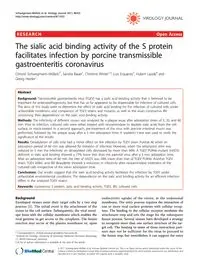
2011 The sialic acid binding activity of the S protein facilitates infection by porcine transmissible gastroenteritis co PDF
Preview 2011 The sialic acid binding activity of the S protein facilitates infection by porcine transmissible gastroenteritis co
RESEARCH Open Access The sialic acid binding activity of the S protein facilitates infection by porcine transmissible gastroenteritis coronavirus Christel Schwegmann-Weßels1*, Sandra Bauer1, Christine Winter1,2, Luis Enjuanes3, Hubert Laude4 and Georg Herrler1 Abstract Background: Transmissible gastroenteritis virus (TGEV) has a sialic acid binding activity that is believed to be important for enteropathogenicity, but that has so far appeared to be dispensable for infection of cultured cells. The aims of this study were to determine the effect of sialic acid binding for the infection of cultured cells under unfavorable conditions, and comparison of TGEV strains and mutants, as well as the avian coronavirus IBV concerning their dependence on the sialic acid binding activity. Methods: The infectivity of different viruses was analyzed by a plaque assay after adsorption times of 5, 20, and 60 min. Prior to infection, cultured cells were either treated with neuraminidase to deplete sialic acids from the cell surface, or mock-treated. In a second approach, pre-treatment of the virus with porcine intestinal mucin was performed, followed by the plaque assay after a 5 min adsorption time. A student’s t-test was used to verify the significance of the results. Results: Desialylation of cells only had a minor effect on the infection by TGEV strain Purdue 46 when an adsorption period of 60 min was allowed for initiation of infection. However, when the adsorption time was reduced to 5 min the infectivity on desialylated cells decreased by more than 60%. A TGEV PUR46 mutant (HAD3) deficient in sialic acid binding showed a 77% lower titer than the parental virus after a 5 min adsorption time. After an adsorption time of 60 min the titer of HAD3 was 58% lower than that of TGEV PUR46. Another TGEV strain, TGEV Miller, and IBV Beaudette showed a reduction in infectivity after neuraminidase treatment of the cultured cells irrespective of the virion adsorption time. Conclusions: Our results suggest that the sialic acid binding activity facilitates the infection by TGEV under unfavorable environmental conditions. The dependence on the sialic acid binding activity for an efficient infection differs in the analyzed TGEV strains. Keywords: coronavirus S protein, sialic acid binding activity, TGEV, IBV, cultured cells Background Enveloped viruses enter their target cells by a two step process [1]. The initial event is the attachment of the virion to the cell surface. Subsequently, the viral envel- ope fuses with the cellular membrane which enables the viral genome to get access to the cytoplasm. The fusion reaction may occur at the plasma membrane or, upon endocytotic uptake of the virion, at the endosomal membrane. The entry process requires the interaction of one or more viral surface proteins with cellular recep- tors. The binding to the cellular receptor mediates the attachment step and sets the stage for the subsequent fusion process. Several viruses have developed a strategy to recognize more than one surface structure of the tar- get cell. The binding to some of these interaction part- ners may not be sufficient for the virus to proceed to the fusion step, but nevertheless it can support the entry * Correspondence:
